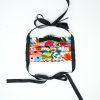Jennifer Morrison, PhD, is an associate research scientist at the Center for Research and Reform in Education at Johns Hopkins University.
One thing I love about living in Baltimore is my neighborhood Facebook groups. You’re sure to find amazing recommendations, from where to get the best crab cakes to what veterinarian to consult. During the first pandemic in more than a century, they’re even more helpful. The three Facebook groups in my area (yes, three!) had quite a few posts about sewn face masks. Nurses were requesting them, along with those considered essential workers. There were all sorts of patterns floating around, then discussions around the challenge of finding materials.
It felt like chaos to me—the lack of a central place to coordinate those requesting masks and those who could make masks. Plus, what pattern would healthcare workers even want? I created a Google sheet for neighbors to organize the efforts. Then, a neighbor commented that she worked for Johns Hopkins Hospital and had been in communication with the hospital’s Healthcare Epidemiology and Infection Control departments. They had a completed pattern ready for distribution, but they needed a person with sewing experience and a machine to create a tutorial. I connected with her and shared that not only do I have a machine and a way to document instructions in photos, but I also happen to have a doctoral degree in instructional design, so I could create the instructions, too. She sent me a photo of the design, and I got to work.
Jennifer Morrison
Full disclosure: I taught myself how to sew last year and my skills are basically straight lines and a hem. I had to check YouTube for a demonstration of how to sew a pleat. The design incorporated pleats, and I hadn’t a clue how to make them, nor how to describe the spacing to someone who did have sewing skills more advanced than mine (probably everyone). I put together the steps with coinciding photos and sent them back to my colleagues at the hospital. They were excited with how things were moving along. Although our timeline was compressed due to the pressing public health need, our team tested it with two volunteer sewing enthusiasts who were able to follow the steps without questions.
Next, I connected with Christina Brunyate, owner of an amazing little fabric shop, Domesticity Fabric Shop and Sewing Studio, in Lauraville. Little did I know, she had a small army of stitchers and was already receiving and communicating requests for sewn masks. I shared our Johns Hopkins Hospital pattern, and the next thing I knew, I had a gorgeously illustrated, professional-looking pattern from one of her colleagues. We did some back-and-forth to correct a few pieces, but I quickly sent that off to my hospital colleagues for them to share on their website. Meanwhile, Christina mobilized even more volunteers by creating a new section on her website to house the pattern. She also added a sign-up section for those people in need of a mask and those people who can sew. She also offered volunteers an option to buy fabric at a reduced rate or to donate fabric for others to sew.
I delivered my first batch of sewn masks to Johns Hopkins Hospital in early April and I have more to work in the weeks ahead. In a time when there’s so much uncertainty, it’s been cathartic to learn a new skill (sewing pleats) and feel like I’m using my training as an instructional designer to help others help themselves and their communities.

